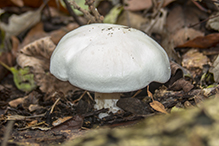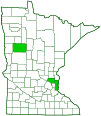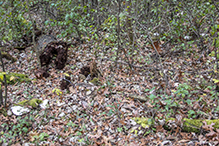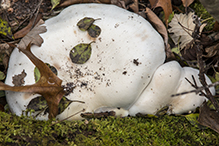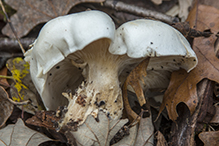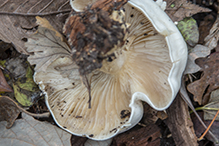Flowery Blewit
(Lepista irina)
Conservation • Description • Habitat • Ecology • Distribution • Taxonomy
Conservation Status |
|
|||||||
| IUCN Red List | not listed |
|||||||
| NatureServe | not listed |
|||||||
| Minnesota | not listed |
|||||||
Description |
||
Flowery Blewit is a common and widespread, medium-to large-sized, gilled mushroom. It is found in late summer and fall woodlands in groups or clusters. It grows on the ground in soil or on woody debris. It often grows in large rings. It obtains its nutrients from decaying organic matter (saprobic). It has a “flowery” odor that is sometimes faint, sometimes strong and sharp. The cap is white, hemispherical, and slightly sticky when it first appears. It soon becomes convex, smooth, and dry, with cottony margins that are rolled under. As it matures, the cap flattens out and may retain a bump or be depressed in the center. When mature, it is white to pinkish-tan and sometimes has a lobed or wavy margin. It is usually 1¼″ to 5″ in diameter, but large specimens up to 9″ in diameter have been collected. Older specimens are pinkish-tan or tan. It is not easily separated from the stalk. The gills are crowded and are broadly attached to the stalk, sometimes slightly running down the stalk. They are white at first but fade to yellowish-pink as they age. The stalk is solid, stout, 1½″ to 3″ long, ⅜″ to 1″ thick, and sometimes swollen at the base. It is white and dry at first. As it matures it develops tan, fibrous, vertical streaks. Older stalks are pale pinkish-brown. The base is usually covered with white, thread-like fibers (mycelium). There is no ring of tissue on the stalk representing remnants of the veil. The flesh is thick, white to pinkish, and soft. It is edible when cooked, according to some sources. However, it contains gastrointestinal irritants, and should be considered poisonous to some people. There are two varieties of Lepista irina. L. i. var. irina has a pale pinkish buff spore print. L. i. var. luteospora has a yellowish spore print. |
||
Similar Species |
||
Habitat and Hosts |
||
Woodlands |
||
Ecology |
||
Season |
||
Late summer and fall |
||
Distribution |
||||
|
Sources |
|||
| 11/20/2022 | ||||
Occurrence |
||||
Common and widespread |
||||
Taxonomy |
|||
| Kingdom | Fungi (Fungi) | ||
| Subkingdom | Dikarya | ||
| Phylum | Basidiomycota (Basidiomycete Fungi) | ||
| Subphylum | Agaricomycotina (Higher Basidiomycetes) | ||
| Class | Agaricomycetes (Mushrooms, Bracket Fungi, Puffballs, and Allies) | ||
| Subclass | Agaricomycetidae | ||
| Order | Agaricales (Common Gilled Mushrooms and Allies) | ||
| Suborder | Tricholomatineae | ||
| Family | Tricholomataceae | ||
| Genus | Lepista (blewits) | ||
Genus Family |
|||
Subordinate Taxa |
|||
Flowery Blewit (Lepista irina irina) Flowery Blewit (Lepista irina luteospora) |
|||
Synonyms |
|||
Agaricus irinus Clitocybe irina Gyrophila irina Rhodopaxillus irinus Tricholoma irinum |
|||
Common Names |
|||
Blushing Bowlcap Flowery Blewit Woolly Lepista |
|||
Glossary
Mycelium
The vegetative part of a fungus; consisting of a mass of branching, thread-like hyphae, through which a fungus absorbs nutrients from its environment; and excluding the fruiting, reproductive structure.
Partial veil
A protective covering over the gills or pores of a developing mushroom. At maturity it disappears, collapses into a ring around the stalk, or wears away into a cobwebby covering and ring zone.
Saprobic
A term often used for saprotrophic fungi. Referring to fungi that obtain their nutrients from decayed organic matter.

Slideshows |
||

Visitor Videos |
|||
Share your video of this mammal. |
|||
| This button not working for you? Simply email us at info@MinnesotaSeasons.com. Attach a video, a YouTube link, or a cloud storage link. |
|||
Other Videos |
|||
| Illatos pereszke - Lepista irina - Veilchen-Rötelritterling Csanád Csebecse |
|||
About
Published on Oct 30, 2015 video made in october 2015 in central hungary |
|||

Visitor Sightings |
|||||
Report a sighting of this fungus. |
|||||
| This button not working for you? Simply email us at info@MinnesotaSeasons.com. Be sure to include a location. |
|||||
|
|||||
MinnesotaSeasons.com Sightings |
|||||

Last Updated:
